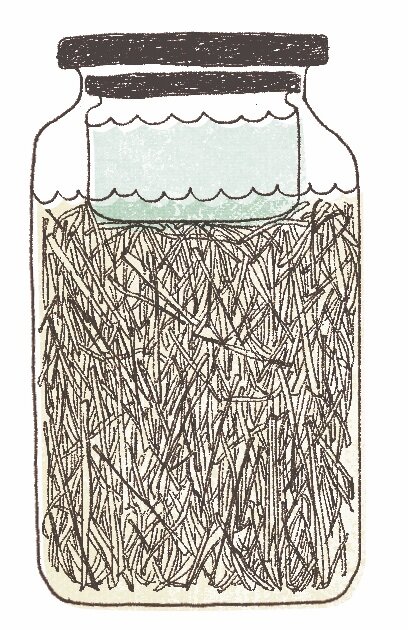
FAQs
Getting Started FAQs!
Scroll through and search. Don’t see the answer you’re looking for? Contact us!
Remember to keep your vegetables below the brine line as best as you can. The pickle weight will help with that!
Instead of a jar, you can use your pickle weight. And no need to put the cap back on - you have your pickle pipe!
I’m ready to start. So where's the vinegar?
We are utilizing the lacto-fermentation method, also known as saltwater pickling. In this method, we will use the natural bacteria found on the skin of the vegetables to preserve the vegetables themselves. We will regulate our little ecosystem with salt. This is an ancient technique discovered by sailors who got a little too much saltwater in their storage barrels. While some fruits and vegetables taste great when preserved in vinegar (ie- onions, peppers, squash), lacto-fermented vegetables like cucumbers, green beans and cabbage develop an outstanding and effervescent tang, and are filled with probiotics!
Does the type of salt matter?
Sure does! Salt regulates the fermentation process, helping to create a mini ecosystem that encourages the growth of good bacteria and inhibits the growth of bad bacteria, which cause vegetables to spoil. Salt also draws out water from the vegetables, concentrating their flavors and keeping them crunchy. There’s no need to purchase special “canning” or “pickling” salts. Any non iodized kosher salt will do (iodine is known to inhibit the growth of bacteria, good or bad).
Language check. What’s the diff btw fermentation and pickling? Pickles vs ferments?
For our purposes, the terms fermentation and pickling are used interchangeably. Fermentation is one form of pickling. We also refer to all pickled vegetables as pickles, though in the USA, the term “pickles” often just refers to cucumbers. In the world of pickling, it’s good to keep an open mind about all of this language!
Where should I leave my jars while they ferment?
Generally speaking, warmer temperatures speed up the fermentation process and cooler temperatures slow it down. An ideal temperature is somewhere between 65° and 75° F. It’s best to leave your jars away from a window or direct sunlight. A non-sunny part of the kitchen counter is probably best.
Why do all the recipes talk about ‘sealing’ the jar, or submerging below the brine?
Keeping your vegetables below the brine line ensures that they’re not exposed to oxygen in the air while still allowing the bubbles (carbon dioxide is a byproduct of the fermentation process) to be released. Any part of the vegetable exposed to oxygen will turn slightly yeasty or moldy. Note that creating a seal for fermented pickles is not the same as sealing a jar when canning. Reference our illustrations at the left of this page—if you use your weight and pipe, you’ll be all set!
I’ve heard of a salt ratio. What’s that?
The salt ratio in your brine matters and is a major key to pickling success. Our recipes stick to a 3.5% to 5% salt solution for fermented pickles. Old-fashioned recipes called for about 10% of the pickle brine to be salt (quite salty). The pickles would last longer without refrigeration, but had to be rinsed with water multiple times before serving. Refrigeration allows for less salty brines so the pickles can be eaten straight from the jar.
Can I put any vegetable at all in a salty brine?
We’ll admit it, some vegetables pickle better with vinegar. Onions, for example, can get slimy in a salty brine. Peppers tend to be happier when pickled in vinegar as well. That said, we’ve provided a wide variety of recipes so you can try your hand at a whole slew of veggies and fruits. Have an item you want to pickle and can’t find how to do it? Let us know!
Troubleshooting FAQs
Laying out your ingredients can really help set you up for success!
Use the wooden tamper to press the cabbage below the brine. Then place your pickle weight on top to keep the cabbage down while it is fermenting.
Help! My pickles look moldy!
White yeast or mold, which commonly forms on the surface of lacto-fermented vegetable brines, is harmless. Just spoon it off and the vegetables should be good to eat. On the off chance that you find black, pink, or green fuzz on the surface of your brine or on your vegetables, be extra vigilant to ensure that you don’t ingest it. If the smell is funky or otherwise off (you’ll know), you may have to toss the batch and start over. The more you ferment, the more you’ll find that odors and colors tell you what’s going on in your crock. If a batch doesn’t work out, don’t feel guilty about tossing it—it’s all part of the learning process. A less-than-perfect batch is also a good opportunity to brainstorm what could be done differently.
Um, can I use tap water?
Tap water often contains chlorine, which kills bacteria. When making a vegetable ferment, the bacteria are critical for a good outcome, and filtered water provides a stronger guarantee of success. However, there are two easy ways to get around using filtered water:
Boil water, then let it cool to room temperature.
Let the water sit, uncovered, for at least 30 minutes (but ideally several hours to let the chlorine evaporate.
We’ve had success with both of these methods, but we also find that MOST tap water is ok too.
I’m ready to make a bigger quantity than my little jar. What can I use instead?
Ceramic, glass, or wood are key! Don’t use metal, a reactive material. There are several plastics that are food-grade and considered safe, but it’s not always simple to know what’s what, so we recommend a #2 HDPE food-grade plastic bucket. Wash your vessels before use, and note that at home it’s not necessary to sanitize them as you would if you were canning.
The brine is so…murky??
With any fermented pickles, white sediment can form at the bottom of the jar as a by-product of lacto-fermentation. Don't worry--it’s healthy. If the sediment is shaken up, it can make the brine look cloudy, which is fine.
Help! My garlic turned blue!
Don’t be afraid of blue garlic in your lacto-fermented experiments. Garlic contains a special enzyme that turns it bluish-green when exposed to copper and aluminum, both of which are found in most tap water.
Help! My pickles are hollow!
Produce quality is everything when it comes to pickling. Think about the origins of the process—preserving the freshest harvest for later!
If you get hollow pickles, they may not have been the best quality cukes to begin with. They may still be delicious, but might not have the crunch you crave. We suggest starting with green beans if cucumbers are not in season—they’re always more consistently good quality. Also, smaller, thinner cucumbers are always better than big ones (which are full of water). We encourage you to be that guy at the farmers market who picks out the precise thin veggies you want. No shame in looking for quality!
Help! The brine keeps spilling out of my jar while my veggies ferment!
This is normal! Your jar of pickling vegetables is alive! The gas produced in the jar (CO2) will often cause the brine to overflow. We always place our jars on a plate or a dish to ensure we’re not spilling all over the counter.
Misc. FAQs
Can I re-use the brine to make my next batch?
While a splash of brine from the last batch might help kickstart the fermentation process, it doesn’t exactly work to simply throw fresh vegetables in previously used batches of brine. Instead, use the leftover brine in your bread recipes, or let meat or chicken soak a few hours in the brine to infuse delicious flavor before cooking! You can make a pickle brine martini, or simply drink the brine as a good-for-the-gut bonus. The possibilities are endless, and once you’re pickling regularly, the brine will be endless too!
Are there any instructional videos you can point us to?
Sure! Here’s a quick video of Liz and Jeffrey making sauerkraut a few years back (pretty comprehensive for a 2-minute video!). And here’s a fun video of Jeffrey making pickles with writer Jamie Attenberg. We’ll insert more videos over time and by request—don’t be shy!
How long will my pickles keep in the fridge?
Once your fermented vegetables are placed in the fridge, they’ll stay “good” for months and months. That said, the nutritional value goes down over time, and the vegetables will still slowly ferment, meaning they’ll get softer and more sour with each passing month. We like to eat our ferments within 4-6 months of making them, but don’t worry if you let yours go longer. Because they are live culture items, they won’t spoil. That said, we strongly discourage you from sticking your fingers in a jar, or double dipping with a fork or spoon. Those processes introduce new bacteria to the jar, meaning that you might end up with some uninvited white fuzz or mold.
Your question here!
We know we can’t anticipate every single pickling Q. So, we’ll be updating this page over time based on your input! Please visit this page to submit your question(s)!




